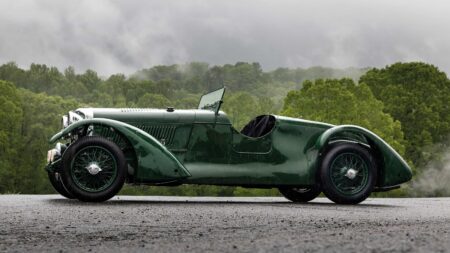I had the chance to inspect it before it went off for restoration, and that is how we have chosen to photograph it: a little tired, slightly down at one corner, traces of rust on the painted green spokes. For this 8-litre is in remarkable, original, condition. These are the very seats on which WO sat, the same doors he pulled shut, the same starter button he thumbed before heading down the A2 for Dover.
For over 30 years the car has belonged to the Majzub family, who maintained it and changed nothing. Julian Majzub remembers it fondly: “My father loved it. A lot of 8-litres went to people who just wanted a car they could wear top hats in, but this is what WO envisaged as his perfect car. A genuine 100mph saloon; you can easily average 80mph.”
That’s confirmed by contemporary reports. The second production chassis, this was the first definitive 8-litre and was the car the firm loaned to magazines for road tests – a car that had a huge impact on the car world. “Motoring in its very highest form,” The Autocar called it. Now that a Cricklewood Bentley is a hobby vehicle and not a means of transport we are used to these huge limousines being turned into Le Mans lookalikes, or seeing the massive engines transplanted into lighter 3- or 4½–litre chassis to go racing. In 1930 you had to choose between travelling quickly and carrying passengers, if comfort mattered. There were open sports cars which would do 90 or 100mph at the cost of an open-air pummelling, and there were comfortable limousines, but even a powerful saloon car could not be expected to whisk four people along at 100mph – until the 8-litre appeared.
Perhaps the BMW M5 had the same sort of impact in our era, proferring 150mph for a quartet of cosseted inhabitants. Or the latest Bentley Flying Spur, which effectively doubles the 8-litre’s top speed with unimpaired luxury. For it was the comfort which WO was selling with his vast new machine: a town carriage as much as a grand tourer, it would pull from walking pace in top gear. Just what today’s S-class or 750i does, but through sheer earth-moving torque, not via a seven-speed autobox. And it had the huge-striding quality which consumes the miles without apparent effort. The Autocar suggested one could breakfast in London and lunch in Catterick – which would be pushing it today. It was such an astonishing combination of qualities that Rolls-Royce, whose Phantom was Bentley’s chief target, did not at first take the 100 claim seriously. When it realised the rumours were true, and that Bentley was in cash trouble, it took decisive action.

Patched leather and worn nickel plate testify to years of preservation
Marc Wright
Surviving Bentley records tell us that Chassis YH5002 went to H J Mulliner in October 1930, where it received a compact Weymann-pattern body with fabric sunroof. WO was a fan of the Weymann system, which used movable joints covered in fabric to give a body which would flex with the chassis, avoiding the creaks and groans of conventional saloons. He commented on the “silence and almost negligible weight.” That mattered, because the whole car weighs almost 2½ tons.
Although coachbuilders were competing to add ever more lavish fittings to large cars, there is none of that here. No cigar companions, cocktail cabinets, or fold-down tables, not even a door pocket, although the dainty nickel-plated window catches have a lovely twist to them which makes you want to fiddle. Driver and passenger sit in beautifully shaped bucket seats, rear passengers on a bench with a small armrest, and the mottled brown leather, with patches, has been in there a very, very long time. Since 1930? The service records say it started out with cloth upholstery (leather was what the chauffeur got in the ’30s; owners preferred to sit on Bedford cloth), so that is one of the decisions Bentley will have to make about the restoration.









